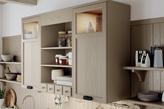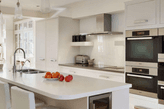How a Designer Plans Your Kitchen?
Designing a kitchen involves much more than choosing colour schemes and selecting appliances. It requires a deep understanding of the client’s needs, preferences, and lifestyle. Senior designer Julia Eissing sheds light on the intricate process of kitchen design and shares valuable insights into the numerous factors to consider in creating functional and beautiful kitchens.
What are some of the essential questions you ask your clients when designing a kitchen?
When consulting with clients, I begin by asking about the primary purpose of their kitchen. Understanding if it’s primarily used for cooking, entertaining, or family gatherings helps me tailor the design accordingly. I also inquire about the number of people who typically use the kitchen simultaneously to ensure efficient flow and functionality.
Budget is another significant factor. How do you navigate it while designing a kitchen?
Understanding the client’s budget range is crucial. I work closely with them to ensure we strike a balance between their desired design and their financial constraints. I provide options and recommendations that align with their budget while still delivering a high-quality and functional kitchen.
Are there any preferred kitchen layouts or styles that you discuss with your clients?
Yes, clients often have a style or layout preference in mind. Some may prefer open-concept kitchens, while others may lean towards a closed kitchen. I discuss their preferences and provide suggestions based on their desired aesthetic and functional goals.
Are habits or preferences a consideration when designing the kitchen?
Absolutely! I ask clients about their cooking habits, such as whether they are avid home chefs or prefer quick and simple meals. This helps me determine the type of appliances and workspace they require. I also inquire about any physical limitations or special needs the users may have, left-handed individuals or those with mobility issues, to ensure the kitchen accommodates their specific requirements.
What about families with children? Are there any special considerations for them?
Safety is paramount when designing a kitchen for families with children. I inquire about the ages of the children and any specific safety concerns. This includes childproofing measures, such as:
- Avoid sharp-edged countertops, islands, and tables. Opt for rounded or bevelled edges instead.
- Designing the kitchen with countertops at different heights to accommodate both adults and children. Lower sections of countertops can serve as a designated workspace for kids, allowing them to participate in meal preparation and baking activities.
- Incorporate sufficient storage solutions to keep children’s utensils, plates, and snacks within easy reach.
Pets are also often a part of many households. Do you consider them in your design process?
Pets are an important consideration. I ask clients about their pets and their specific needs. For example, incorporating a pet feeding station or creating storage solutions for pet supplies and food can be essential. Once, I had a client who made a unique request and wanted to integrate a dog crate in the island. It turned out to be a great addition.
Storage is always a concern in kitchens. How do you approach this aspect?
Storage is crucial, and I inquire about the client’s storage needs. I ask about the number and types of kitchen items they have, including large appliances and specialised cookware. This helps me design efficient storage solutions, such as pantry space, drawers, and cabinets with internal solutions, ensuring everything has its place.
What about materials and finishes? How do you approach those?
Materials and finishes play a vital role in the design of the kitchen. I discuss with clients their preferences for cabinet fronts and worktops. We consider factors such as durability, ease of maintenance, and how well the materials align with their desired style and colour scheme.
Are there any specific architectural features or existing design elements that you consider when designing a kitchen?
If there are any architectural features in the kitchen space, such as exposed beams or unique alcoves, I focus on how we can incorporate or enhance these elements in the design. It adds character and makes the kitchen feel cohesive with the rest of the home.
Designing a kitchen involves a holistic approach that considers the client’s needs, lifestyle, and preferences. Through thoughtful questions and considerations, our Kaiser designers ensure that every aspect aligns with the client’s vision. By understanding these essential elements, clients can work collaboratively with our designers to create their dream kitchen that not only reflects their style but also enhances their everyday lives.


